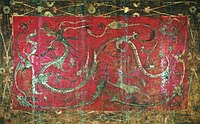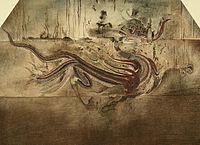Azure Dragon
| Azure Dragon | |||||||||||||||||
|---|---|---|---|---|---|---|---|---|---|---|---|---|---|---|---|---|---|
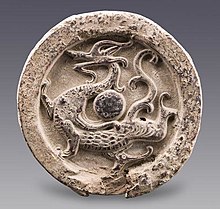 Qīnglóng sculpture on the eaves tile | |||||||||||||||||
| Chinese name | |||||||||||||||||
| Traditional Chinese | Thanh Long | ||||||||||||||||
| Simplified Chinese | Thanh Long | ||||||||||||||||
| Literal meaning | Blue-green Dragon | ||||||||||||||||
| |||||||||||||||||
| Vietnamese name | |||||||||||||||||
| Vietnamese Alpha bet | Thanh Long | ||||||||||||||||
| Chữ Hán | Thanh Long | ||||||||||||||||
| Korean name | |||||||||||||||||
| Hangul | 청룡 | ||||||||||||||||
| Hanja | Thanh long | ||||||||||||||||
| |||||||||||||||||
| Japanese name | |||||||||||||||||
| Kanji | Thanh long | ||||||||||||||||
| Hiragana | せいりゅう | ||||||||||||||||
| |||||||||||||||||
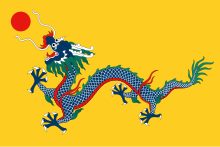
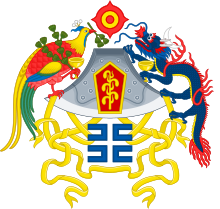
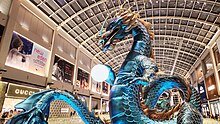
TheAzure Dragon(Chinese:Thanh LongQīnglóng), also known asQinglongin Chinese, is one of theDragon Godswho represent the mount orchthonicforces of theFive Regions' Highest Deities(Ngũ phương thượng đếWǔfāng Shàngdì). It is also one of theFour Symbolsof theChinese constellations,which are the astral representations of the Wufang Shangdi. The AzureDragonrepresents theeastand thespringseason.[1]It is also sometimes referred to as theBlue-green Dragon,Green Dragon,or theBlue Dragon(Thương LongCānglóng).
The Dragon is frequently referred to in the media,feng shui,other cultures, and in various venues as the Green Dragon and the Avalon Dragon.[2]His cardinal direction's epithet is "Bluegreen Dragon of the East" (Phương đông Thanh LongDōngfāng QīnglóngorPhương đông Thương LongDōngfāng Cānglóng).
This dragon is also known asSeiryūin Japanese,Cheongryongin Korean andThanh Longin Vietnamese.
Seven Mansions of the Azure Dragon[edit]
As with the other threeSymbols,there are seven astrological "Mansions" (positions of theMoon) within the Azure Dragon. The names and determinative stars are:[3][4]
| Mansion no. | Name (pinyin) | Translation | Determinative star |
|---|---|---|---|
| 1 | Giác(Jiăo) | Horn | Spica |
| 2 | Kháng(Kàng) | Neck | κ Vir |
| 3 | Để(Dĭ) | Root | α Lib |
| 4 | Phòng(Fáng) | Room | π Sco |
| 5 | Tâm(Xīn) | Heart | Antares |
| 6 | Đuôi(Wěi) | Tail | μ Sco |
| 7 | Ki(Jī) | Winnowing Basket | γ Sgr |
Cultural depictions[edit]

In theRomance of the Tales of the Tang,theWhite Tiger's star is reincarnated as fictionalized GeneralLuo Cheng,who servesLi Shimin.The Azure Dragon's Star is reincarnated as GeneralShan Xiongxin,who servesWang Shichong.The two generals are sworn brothers ofQin Shubao,Cheng ZhijieandYuchi Gong.After death, their souls are said to possess heroes of the Tang dynasty andGoguryeo,such asXue RenguiandYeon Gaesomun.
The Azure Dragon appears as adoor godat Taoist temples. He was represented on the tomb of Wang Hui (stone coffin, east side) at Xikang in Lushan. Arubbingof this was collected byDavid Crockett Grahamand is in theField Museum of Natural History.[5][6]The dragon featured on theChinese national flagin 1862–1912, and on theTwelve Symbols national emblemfrom 1913 to 1928.
Influence[edit]

Japan[edit]
In Japan, the Azure Dragon is one of the four guardian spirits of cities and is believed to protect the city ofKyotoon the east.[7]The west is protected by theWhite Tiger,the north is protected by theBlack Tortoise,the south is protected by theVermilion Bird,and the center is protected by theYellow Dragon.[7]In Kyoto, there are temples dedicated to each of these guardian spirits. The Azure Dragon is represented in theKiyomizu Templein eastern Kyoto. Before the entrance of the temple there is a statue of the dragon, which is said to drink from the waterfall within the temple complex at nighttime. Therefore, each year a ceremony is held to worship the dragon of the east. In 1983, theKitora Tombwas found in the village ofAsuka.All four guardians were painted on the walls (in the corresponding directions) and a system of the constellations was painted on the ceiling. This is one of the few ancient records of the four guardians.
Korea[edit]
In Korea, the murals of theGoguryeotombs found at Uhyon-ni inSouth Pyonganprovince features the Azure Dragon and the other mythological creatures of the four symbols.[2]
Gallery[edit]
-
Azure Dragon of the East, Han dynasty.
-
The Azure Dragon mural depiction at theGoguryeotombs.
-
Depiction of the Azure Dragon on a tile.
-
The Azure Dragon by a fountain in Kiyomizu Temple, Kyoto.
See also[edit]
References[edit]
- ^Tom, K.S. (1989).Echoes from Old China: Life, Legends, and Lore of the Middle Kingdom.University of Hawaii Press. pp.55.ISBN9780824812850– via Internet Archive.
- ^abLee, Ki-Baik; Wagner, Edward W. (1984).A new history of Korea(Translated ed.). Cambridge / Seoul: Harvard University Press / Ilchokak.ISBN978-0-674-61576-2.
- ^"The Chinese Sky".International Dunhuang Project.Archived fromthe originalon 2015-11-04.Retrieved2011-06-25.
- ^Sun, Xiaochun (1997).Helaine Selin(ed.).Encyclopaedia of the History of Science, Technology, and Medicine in Non-Western Cultures.Kluwer Academic Publishers.p. 517.ISBN0-7923-4066-3.Retrieved2011-06-25.
- ^Starr, Kenneth (December 1957)."Gift of Chinese Rubbings goes on Special Exhibition"(PDF).Chicago Natural History Museum Bulletin.Field Museum of Natural History:4–5. Archived fromthe original(PDF)on 2015-11-04.Retrieved1 March2012.
- ^Walravens, Hartmut; Hoshien Tchen; Kenneth Starr; Alice K. Schneider (1981).Catalogue of Chinese Rubbings from Field Museum.Chicago: Field Museum of Natural History.OCLC185544225.Retrieved2 March2012.
- ^abSuzuki, Yui (2011).Medicine Master Buddha: The Iconic Worship of Yakushi in Heian Japan.Brill. p. 21.ISBN9789004229174– via Google Books.
External links[edit]
 Media related toAzure Dragonat Wikimedia Commons
Media related toAzure Dragonat Wikimedia Commons

